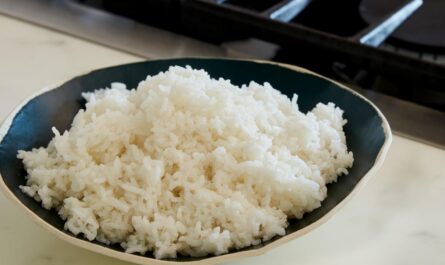For many sushi enthusiasts, the quest for perfect ingredients is never-ending. Among the myriad of options available, black rice stands out not only for its rich color and nutty flavor but also for its impressive nutritional profile. One of the key nutrients in black rice is iron. Understanding black rice iron absorption can help sushi lovers make informed choices about incorporating this ancient grain into their meals.

The Nutritional Power of Black Rice
Black rice, often referred to as forbidden rice, is not just a staple for its aesthetic appeal but also for its health benefits. Packed with antioxidants, vitamins, and minerals, this grain has been a part of Asian cuisine for centuries. But what about its iron content? Black rice provides a significant amount of iron, a mineral crucial for various bodily functions, including the formation of red blood cells.
What Makes Iron Important?
Iron is an essential mineral that plays a vital role in our bodys ability to transport oxygen. It is a fundamental component of hemoglobin, the protein in red blood cells responsible for carrying oxygen from the lungs to the rest of the body. Without adequate iron, the body struggles to produce enough healthy red blood cells, leading to conditions like anemia.
How Does the Body Absorb Iron?
Iron absorption is a complex process influenced by several factors, including the type of iron present in food. The two primary types of dietary iron are heme and non-heme iron. Heme iron, found in animal products, is typically absorbed more efficiently by the body than non-heme iron, which is present in plant-based foods like black rice.
Enhancing Iron Absorption from Black Rice
To optimize black rice iron absorption, its beneficial to combine it with foods high in vitamin C. Vitamin C acts as a powerful enhancer of non-heme iron absorption by transforming it into a form more easily absorbed by the body. Consider pairing black rice with ingredients like bell peppers, oranges, or strawberries in your sushi rolls.
Cooking Techniques to Boost Iron Levels
Another way to improve iron absorption is through proper cooking techniques. Soaking black rice before cooking can help reduce phytic acid levels, a compound found in grains and legumes that can inhibit iron absorption. By soaking and rinsing the rice, you can make the iron more bioavailable.
Comparing Black Rice with Other Rice Varieties
While black rice is celebrated for its health benefits, its essential to compare it with other rice varieties to understand its unique advantages. Compared to white and brown rice, black rice contains more antioxidants and a higher iron content. This makes it an excellent choice for those looking to boost their nutrient intake.
Antioxidant Richness in Black Rice
The deep purple hue of black rice comes from its high anthocyanin content, an antioxidant linked to numerous health benefits, including reduced inflammation and improved heart health. For sushi lovers, incorporating black rice can enhance not only the visual appeal of dishes but also their nutritional value.
Exploring Sushi Variations with Black Rice
For sushi aficionados, black rice offers an exciting twist on traditional rolls. Its striking color and nutty flavor make it a perfect alternative to white rice. By experimenting with different fillings and combinations, sushi lovers can create unique and healthful dishes that are both delicious and nutritious.
Black Rice in Sushi Rolls
Black rice can be used as a base for a variety of sushi rolls. Consider pairing it with fresh vegetables, lean proteins, or even fruits for a refreshing twist. The possibilities are endless, allowing for creative and flavorful culinary explorations.
Incorporating Black Rice into a Balanced Diet
While black rice is a nutritional powerhouse, its essential to incorporate it into a balanced diet. Consuming a variety of grains, fruits, vegetables, and proteins ensures that you receive a wide range of nutrients necessary for overall health and well-being.
Pairing Black Rice with Other Superfoods
To maximize health benefits, consider pairing black rice with other superfoods like avocados, leafy greens, and fatty fish. These combinations not only provide a diverse range of nutrients but also create flavorful and satisfying meals.
Potential Dietary Considerations
While black rice is generally safe for most people, those with specific dietary restrictions or allergies should consult with a healthcare professional before making significant dietary changes. For more information on potential allergies, visit black rice allergy.
Is Black Rice Suitable for Everyone?
Although black rice is gluten-free and suitable for those with celiac disease or gluten intolerance, individuals with specific health conditions should consider their unique dietary needs. Consulting with a nutritionist can provide personalized guidance.
FAQs
What is the best way to cook black rice?
Soaking black rice before cooking can help enhance its nutrient absorption. Cook it similarly to other rice varieties, using a 2:1 water-to-rice ratio for optimal texture.
Can black rice be eaten raw?
While some grains can be consumed raw, it is not recommended to eat black rice raw. Cooking it ensures that the nutrients are more bioavailable and reduces the risk of digestive issues. Learn more about this at eating black rice raw.
Is black rice good for digestion?
Black rice is rich in fiber, which can aid digestion and promote a healthy gut. For more insights, check out black rice digestion.

Conclusion
For sushi lovers seeking to enhance their culinary experience while reaping health benefits, black rice is an excellent choice. Its impressive iron content and ability to absorb iron efficiently make it a valuable addition to any diet. By understanding the factors that affect black rice iron absorption and how to optimize it, you can enjoy delicious and nutritious meals that support overall well-being.
For more detailed information on the health benefits of various rice types, visit Healthiest Rice.
This article contains affiliate links. We may earn a commission at no extra cost to you.



